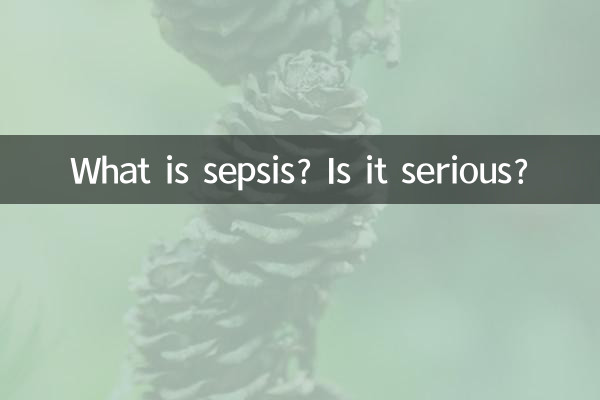What is sepsis? Is it serious?
In recent years, sepsis, as a serious infectious disease, has frequently appeared in the public eye. This article will combine the hot topics and hot content on the Internet in the past 10 days to provide you with a detailed analysis of the definition, symptoms, dangers and preventive measures of sepsis.
1. Definition of sepsis

Sepsis refers to a syndrome in which pathogenic microorganisms (such as bacteria, viruses, fungi, etc.) invade the blood circulation system, grow and reproduce in it, and trigger a systemic inflammatory response. It is a serious complication of infection that, if left untreated, can lead to organ failure or even death.
2. Symptoms of sepsis
The symptoms of sepsis are diverse. In the early stage, they may include fever, chills, increased heart rate, etc. As the disease progresses, the following symptoms may appear:
| Symptom type | Specific performance |
|---|---|
| systemic symptoms | High fever or low temperature, chills, fatigue, shortness of breath |
| circulatory symptoms | Low blood pressure, increased heart rate, pale or cyanotic skin |
| neurological symptoms | Confusion, drowsiness, coma |
| Other symptoms | Decreased urine output, abdominal pain, nausea and vomiting |
3. Severity of sepsis
Sepsis is a very serious disease, and its harm is mainly reflected in the following aspects:
| Hazard type | specific impact |
|---|---|
| high mortality | Untreated sepsis has a mortality rate of 30%-50% |
| multiple organ failure | May cause failure of important organs such as heart, lungs, liver, kidneys, etc. |
| long term sequelae | Survivors may suffer from cognitive impairment, physical disabilities, etc. |
4. High-risk groups for sepsis
The following groups are more likely to develop sepsis and require special attention:
| high risk groups | risk factors |
|---|---|
| infants | Imperfect immune system development |
| elderly | Immune function decline |
| Chronic disease patients | Basic diseases such as diabetes and liver cirrhosis |
| Immunocompromised persons | AIDS patients, chemotherapy patients, etc. |
5. Prevention and treatment of sepsis
The key to preventing sepsis is to promptly treat the source of infection and enhance immunity:
| Precautions | Specific practices |
|---|---|
| Treat infection promptly | Seek medical attention promptly for wounds, lung infections, etc. |
| maintain hygiene | Wash hands frequently and disinfect regularly |
| Enhance immunity | Balanced diet, regular work and rest, appropriate exercise |
In terms of treatment, sepsis requires immediate medical attention, which usually includes:
| Treatment | Specific content |
|---|---|
| antibiotic treatment | Choose the right antibiotic based on the pathogen |
| fluid resuscitation | Maintain stable blood circulation |
| organ support | Use ventilator, dialysis, etc. when necessary |
6. Recent hot topics about sepsis
In the past 10 days, discussions about sepsis have mainly focused on the following aspects:
1.The relationship between COVID-19 sequelae and sepsis: Some studies have pointed out that some severe COVID-19 patients may be complicated by sepsis.
2.Antibiotic resistance problem: The increasing difficulty in treating sepsis caused by drug-resistant strains has caused concern.
3.Artificial Intelligence Assisted Diagnosis: The application of new technologies in early identification of sepsis has become a hot topic.
4.Lack of public awareness: Surveys show that most people don’t know enough about the seriousness of sepsis.
Conclusion
Sepsis is a serious life-threatening disease, but its harm can be significantly reduced by raising awareness of prevention, timely medical treatment and standardized treatment. If you or your family members develop suspected symptoms, please seek medical treatment immediately and do not delay treatment.

check the details

check the details